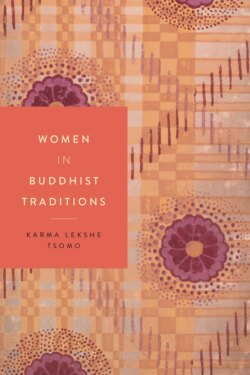Women in Buddhist Traditions

Реклама. ООО «ЛитРес», ИНН: 7719571260.
Оглавление
Karma Lekshe Tsomo. Women in Buddhist Traditions
CONTENTS
NOTE ON TRANSLITERATION AND PRONUNCIATION OF NAMES AND TERMS
Introduction
History in the Mirror
Buddhist Principles, Social Practices
Revolutionizing the Future
1. Women in Early Indian Buddhism
Buddhist Women at the Beginning
Representations of Women in Early Buddhist Texts
Mahāprajāpatī’s Going Forth
The Prediction of Decline
Women Disseminating the Dharma
Lamps of Liberation
2. Buddhist Women in South and Southeast Asia
Engendering Connections: Women in Theravāda Buddhism
Buddhist Women as Householders and Renunciants
Women in Burmese Theravāda Buddhism
3. Buddhist Women in East Asia
Women’s Responsibilities and Renunciation in Early Chinese Buddhism
Enlightenment in Female Form in China
Buddhist Women of Korea
Buddhist Women of Japan
East Asian Women in the Twenty-First Century
4. Buddhist Women in Inner Asia
Buddhist Women of Tibet
Luminary Figures
Freedom in Exile
Buddhist Studies and Full Ordination for Women
Tracing the Footsteps of Women in Bhutan
Women in the Revival of Buddhism in Mongolia
Women in the Buddhist Republics of Russia
Enlightened Transformation
5. Buddhist Women in the West
Pioneering Buddhist Women
Challenging Patriarchy, Building Alliances
Buddhism and Sexuality
Clashes and Acculturation, Cultural and Conceptual
Obstacles as Opportunities
6. Women’s Ordination across Cultures
The Debate over Full Ordination for Women
The Case for Celibacy
Ordination for Women in the Theravāda Tradition
Theravāda Nuns in Nepal
Theravāda Nuns in Sri Lanka
Theravāda Nuns in Thailand
Bhikṣuṇī Ordination in East Asia
Ordination for Women in the Tibetan Tradition
Slow Steps Forward
7. Grassroots Revolution
Being Good or Doing Good?
Buddhism and Gender Justice
Transnational Sisterhood: Women Transforming Buddhism
Buddhist Women and Social Justice: Intersections of Awakening
Social Justice, Inclusion, and Integrity
Conclusion
Buddhist Feminism in Asia: Intersections of Awareness
Gender Equity as a Transnational Buddhist Ideal
Buddhist Constructions of Gender
Transnational Pathways to Gender Equity
ACKNOWLEDGMENTS
QUESTIONS FOR DISCUSSION. INTRODUCTION: WHY STUDY WOMEN IN THE BUDDHIST TRADITIONS?
CHAPTER 1: WOMEN IN EARLY INDIAN BUDDHISM
CHAPTER 2: BUDDHIST WOMEN IN SOUTH AND SOUTHEAST ASIA
CHAPTER 3: BUDDHIST WOMEN IN EAST ASIA
CHAPTER 4: BUDDHIST WOMEN IN INNER ASIA
CHAPTER 5: BUDDHIST WOMEN IN THE WEST
CHAPTER 6: WOMEN’S ORDINATION ACROSS CULTURES
CHAPTER 7: GRASSROOTS REVOLUTION: BUDDHIST WOMEN AND SOCIAL ACTIVISM
CONCLUSION
FOR FURTHER READING
NOTES. INTRODUCTION
1. WOMEN IN EARLY INDIAN BUDDHISM
2. BUDDHIST WOMEN IN SOUTH AND SOUTHEAST ASIA
3. BUDDHIST WOMEN IN EAST ASIA
4. BUDDHIST WOMEN IN INNER ASIA
5. BUDDHIST WOMEN IN THE WEST
6. WOMEN’S ORDINATION ACROSS CULTURES
7. GRASSROOTS REVOLUTION
CONCLUSION
WORKS CITED
INDEX
ABOUT THE AUTHOR
Отрывок из книги
WOMEN IN BUDDHIST TRADITIONS
Series Editor: Catherine Wessinger
.....
The Buddha taught that all beings have the potential to purify their minds and become free from mental defilements, suffering, and rebirth. As the various Buddhist traditions developed, a woman could aspire to the highest goal envisioned by her tradition, whether to become an arhat (a liberated being), a bodhisattva (a being on the path to perfect awakening), or even a fully awakened Buddha. Even if the path was described as arduous, especially in a female body, a woman could achieve the highest goal her tradition had to offer, in theory at least. In the tradition known today as Theravāda (“path of the elders”), prevalent in South and Southeast Asia, the goal is to become an arhat, one who is liberated from cyclic existence. In the tradition known as Mahāyāna (“great vehicle”), prevalent in North and East Asia, the goal is to advance on the bodhisattva path to become a fully awakened buddha. Many statements denying that a woman can become a buddha appear in both Theravāda and Mahāyāna texts, but the existence of numerous female arhats during the time of the Buddha is ample evidence that women were able to achieve that specific goal. In the Mahāyāna tradition, it is believed that all sentient beings not only are capable of becoming buddhas but also will eventually become buddhas. It follows that women have the potential to become fully awakened buddhas. However, according to the Sūtrayāna branch of the Mahāyāna tradition, although it is possible for a woman to practice on the bodhisattva path and stages in a female body and eventually become a buddha, in her final lifetime she must appear in a male body, like Buddha Śākyamuni. In the Vajrayāna branch of the Mahāyāna tradition, which teaches practices of visualizing oneself in the form of a fully awakened being, it is said that a woman can become a buddha in female form. The classic example is Tārā, an exceptional woman who generated a strong determination to achieve full awakening in female form for the benefit of sentient beings, and successfully did so.14
Only the Mahīśāsaka, an early Buddhist school of thought, in which phenomena are regarded as existing only in the present moment, taught that a woman cannot become a fully awakened buddha, but this school died out in India long ago.15
.....